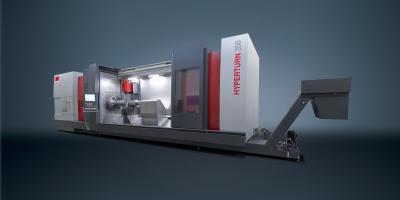
The Hyperturn 200 Powermill high-performance milling-turning center from Emco is for machining large workpieces up to 1,000 mm in turning diameter and for lengths up to 6,000 mm, workpiece weight of 1,500 kg in the chuck and up to 6,000 kg between chuck and tailstock. The powerful main spindle is designed for heavy cutting with a maximum torque of 6,410 Nm and 84 kW. The machine can process large, complex workpieces in general machining, aerospace, shipbuilding, power engineering and the production of shafts for diesel engines.
The moving column of the Hyperturn 200 Powermill is built in a “box-in-box” ram construction, assuring optimal rigidity and stability for machining with a high level of accuracy, the company reports. The B-axis is equipped with a torque motor and integrated into the ram design. The cross slides consist of a welded steel construction with high torsional and bending stiffness, a crucial factor for the quality of the turning and milling.
The machine feautures a turning spindle with 84 kW, 6,400 Nm torque, milling spindle with 80 kW at 700 Nm.
The machine can be equipped with two different milling spindles. The basic machine is equipped with a high-torque milling spindle (430/630 NM) at 6,500 rpm, and optionally a high-speed milling spindle (10,000 rpm/230/340 nm) is available as an alternative, such as for the special machining of light metal alloys and aluminum.
The robust and flexible tailstock can be expanded with a high-quality counter spindle with the same specifications as the main spindle.
The basic machine provides 50 tool positions at the front; 100 and 200 positions are also an option, available either with an HSK 100 or Capto C8 connector. Other customer-specific adjustments are in the number of NC steady rests that can be used, 5-axis simultaneous machining, automatic tool presets and workpiece measurement sensors, and a boring bar pick-up system.
The HT 200 Powermill is equipped with a Siemens 840D sl including Shop-Turn, which is successfully used in the other models from the Hyperturn range. Users can use the EMCO CPS Pilot system for the 1:1 virtual machine, as well as 100 percent simulation of the machining with collision detection.
Contact Details
Related Glossary Terms
- alloys
alloys
Substances having metallic properties and being composed of two or more chemical elements of which at least one is a metal.
- boring
boring
Enlarging a hole that already has been drilled or cored. Generally, it is an operation of truing the previously drilled hole with a single-point, lathe-type tool. Boring is essentially internal turning, in that usually a single-point cutting tool forms the internal shape. Some tools are available with two cutting edges to balance cutting forces.
- boring bar
boring bar
Essentially a cantilever beam that holds one or more cutting tools in position during a boring operation. Can be held stationary and moved axially while the workpiece revolves around it, or revolved and moved axially while the workpiece is held stationary, or a combination of these actions. Installed on milling, drilling and boring machines, as well as lathes and machining centers.
- chuck
chuck
Workholding device that affixes to a mill, lathe or drill-press spindle. It holds a tool or workpiece by one end, allowing it to be rotated. May also be fitted to the machine table to hold a workpiece. Two or more adjustable jaws actually hold the tool or part. May be actuated manually, pneumatically, hydraulically or electrically. See collet.
- gang cutting ( milling)
gang cutting ( milling)
Machining with several cutters mounted on a single arbor, generally for simultaneous cutting.
- milling
milling
Machining operation in which metal or other material is removed by applying power to a rotating cutter. In vertical milling, the cutting tool is mounted vertically on the spindle. In horizontal milling, the cutting tool is mounted horizontally, either directly on the spindle or on an arbor. Horizontal milling is further broken down into conventional milling, where the cutter rotates opposite the direction of feed, or “up” into the workpiece; and climb milling, where the cutter rotates in the direction of feed, or “down” into the workpiece. Milling operations include plane or surface milling, endmilling, facemilling, angle milling, form milling and profiling.
- numerical control ( NC)
numerical control ( NC)
Any controlled equipment that allows an operator to program its movement by entering a series of coded numbers and symbols. See CNC, computer numerical control; DNC, direct numerical control.
- stiffness
stiffness
1. Ability of a material or part to resist elastic deflection. 2. The rate of stress with respect to strain; the greater the stress required to produce a given strain, the stiffer the material is said to be. See dynamic stiffness; static stiffness.
- turning
turning
Workpiece is held in a chuck, mounted on a face plate or secured between centers and rotated while a cutting tool, normally a single-point tool, is fed into it along its periphery or across its end or face. Takes the form of straight turning (cutting along the periphery of the workpiece); taper turning (creating a taper); step turning (turning different-size diameters on the same work); chamfering (beveling an edge or shoulder); facing (cutting on an end); turning threads (usually external but can be internal); roughing (high-volume metal removal); and finishing (final light cuts). Performed on lathes, turning centers, chucking machines, automatic screw machines and similar machines.
